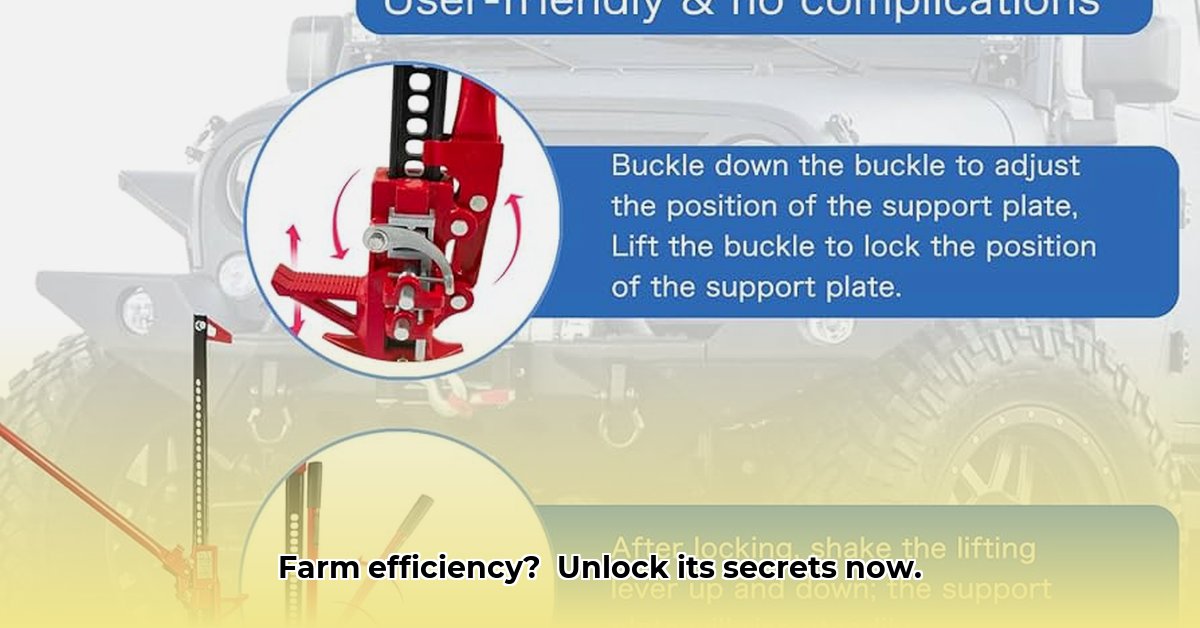
Need a helping hand around the farm? A Hi-Lift jack from Tractor Supply could be your new best friend. This versatile tool tackles countless farm chores, saving you time, effort, and your back. It's more than just for lifting cars; its applications in sustainable agriculture are surprisingly extensive. For even more heavy-duty lifting solutions, check out these wood splitters.
What Makes a Hi-Lift Jack a Farm Essential?
Think of a Hi-Lift jack as a powerful, adaptable lever. Tractor Supply's Hi-Lift jacks are known for their impressive lifting capacity – thousands of pounds! But its real value is its versatility. It's a jack-of-all-trades for various farm tasks.
Putting Your Hi-Lift Jack to Work Around the Farm:
The applications of a Hi-Lift jack extend far beyond vehicle repair. Let's explore its practical uses in sustainable agriculture:
Fence Repair: Easily lift sagging fence posts for repairs or replacements, eliminating back-breaking work. Did you know that efficiently maintained fences contribute to better grazing management and reduce livestock stress?
Irrigation System Maintenance: Lift and maneuver irrigation pipes for cleaning, repairs, or adjustments, improving water efficiency. Efficient irrigation translates to reduced water waste, a key component of sustainable farming.
Equipment Maintenance: Lift smaller machinery for easier inspections and maintenance, reducing downtime and extending equipment lifespan. Regular maintenance is crucial for maximizing the lifespan of expensive farm equipment—a key part of sustainable farm budgeting.
Heavy Lifting: Assist in moving heavy objects like rocks or logs, minimizing physical strain. This reduces the need for additional labor and potential injuries.
Using Your Hi-Lift Jack Safely: A Step-by-Step Guide
Safety is paramount when using heavy equipment. Follow these steps for safe and efficient Hi-Lift jack operation:
Assess the Load: Estimate the weight carefully. Never exceed the jack's maximum capacity (check your manual!). Overloading is extremely dangerous. Don't underestimate the importance of this step. Improper weight assessment is a leading cause of Hi-Lift jack accidents.
Secure the Load: Use sturdy base plates and strong straps to distribute weight evenly. A poorly secured load is a recipe for disaster. Remember, safety straps are more than just a nice addition; they are essential safety components.
Find Stable Ground: Place the jack on level, solid ground capable of supporting the combined weight of the jack and the load. An unstable base could lead to serious accidents. Always double-check your base for stability before you begin.
Lift Slowly and Smoothly: Avoid jerky movements. If you encounter unexpected resistance, cease operation immediately. Slow and steady wins the race, especially with heavy lifting.
Teamwork Makes the Dream Work: Never work alone. Have a spotter for assistance and safety. A second pair of eyes can prevent accidents. Two people are simply better than one when dealing with heavy loads.
Lower Carefully: Lower the load slowly and controlled to prevent damage to both the load and the jack. This helps ensure equipment longevity, a crucial factor in sustainable farming practices.
Regular Maintenance: Clean, lubricate, and inspect the jack regularly for wear and tear. A well-maintained jack is a safe jack. Prevention is key to ensuring both your safety and the long-term performance of your Hi-Lift Jack.
Weighing the Pros and Cons: Is a Hi-Lift Jack Right for You?
Like any tool, the Hi-Lift jack has advantages and disadvantages:
| Pros | Cons |
|---|---|
| High lifting capacity | Requires careful setup and operation |
| Versatile | Can be challenging in confined spaces |
| Relatively affordable | Needs regular maintenance for optimal performance |
| Durable and long-lasting with proper care | Potential to damage surfaces if used improperly |
Practical Applications in Sustainable Agriculture
Let's delve into specific sustainable farming applications:
1. Fence Repair and Maintenance:
- Assess fence damage.
- Position the jack securely.
- Lift the post gradually.
- Secure the post.
- Repeat as needed.
This method significantly reduces soil compaction and fuel consumption compared to using heavier machinery.
2. Irrigation System Adjustments:
- Locate the pipe section needing adjustment.
- Position the jack beneath the pipe.
- Lift the pipe slowly into place.
- Secure the adjusted pipe.
- This improves water usage efficiency.
Careful adjustment prevents water loss and reduces wasted resources.
3. General Farm Lifting and Stabilization:
The Hi-Lift jack can lift and stabilize various farm implements, reducing the need for specialized lifting equipment.
Safety First: Responsible Hi-Lift Jack Usage
Always prioritize safety. Follow the manufacturer’s instructions, wear appropriate safety gear, and never exceed the jack's rated capacity.
Combining Hi-Lift Jacks with Precision Farming Technology
The Hi-Lift jack, while a seemingly basic tool, complements broader precision farming initiatives by enhancing efficiency and sustainability. It's a cost-effective way to improve your farm’s efficiency. Integrating this simple tool into your workflow can contribute significantly to sustainable practices.